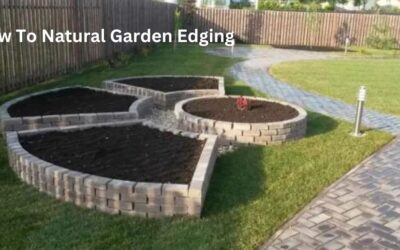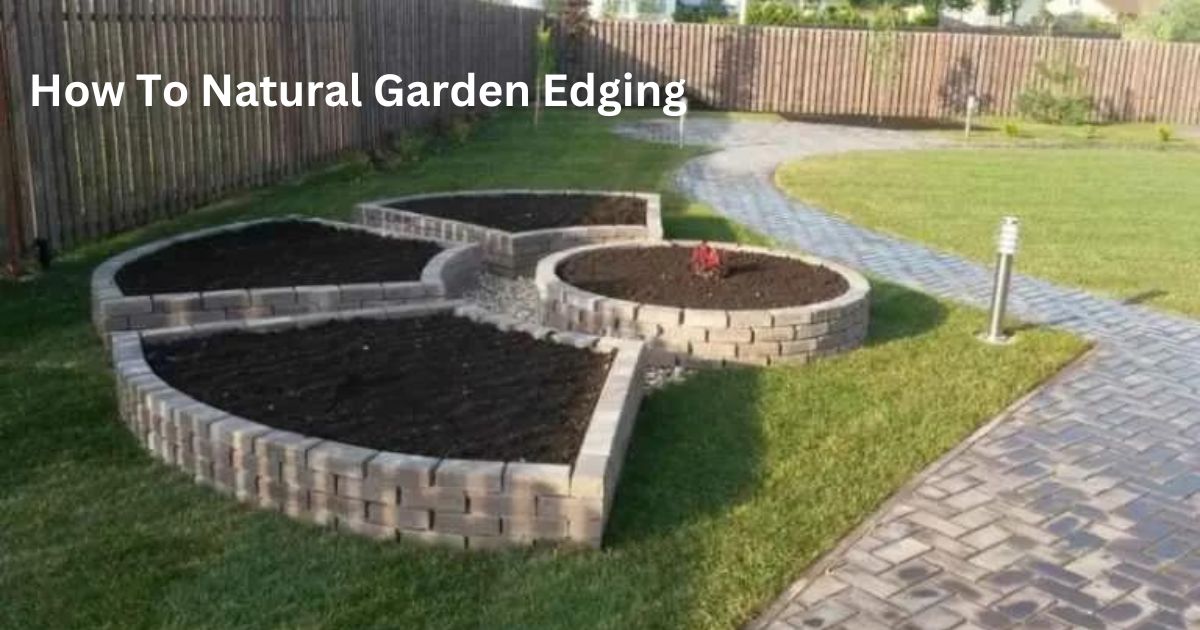This task has a big impact on natural garden edging: creating edge borders that are pleasing to the eye (either straight lines or gently curved, depending on your taste) and a barrier to grass and border plants encroaching on the space of others.
Therefore, creating and maintaining clean borders is an important topic among gardeners, one that I am frequently asked about. Typically, the asker tries to avoid the expense of bricks or stones, like the beautiful ones you see above, not to mention the extra work required after mowing the grass. Yes, this pretty edging requires a lot of maintenance, requiring the gardener to use shears of some kind to cut the grass along it because lawnmowers can’t get close enough to those stones.
I say whatever works. Some people have had success pounding metal or plastic edging into the ground so the mower can cut right over it. However, if you don’t like that look or don’t want to purchase it, there is another completely garden edging natural stone method of edging—the method I use in my garden—that works just as well.
How to Do It?
It’s simple. Dig straight down 3 inches along the lawn’slawn’s perimeter with a shovel with a flat edge. Next, excavate a second slice at a 45-degree angle toward the bed or border. As a result, you’ll have a trench that slopes upward toward the border for flagstone patio and descends straight on the lawn side. Take out the excess dirt. After that, mulch the border, letting some mulch cover the new ‘sedge’s landscape edging on slope, and presto! You’ll have a sharp-looking yet organic edge.

Why Should You Natural Edge Mulch Bed?
Adding a garden border to your home is a simple, low-cost way to improve its curb appeal. A well-kept garden may even raise the value of your home.
However, the natural edge garden is about more than looks. In addition, it can keep grass from growing through your garden area and contain your mulch. The good news is that installing garden edging natural can be low-cost or even free. To get the most basic edging, all you have to do is dig a small barrier between the lawn and the garden with a spade or spade. Although this method will save you money, it will require regular maintenance in the future to keep your edge clean.
There is a better way. You can inaugurate a permanent garden edging material that will keep the lawn and garden separate without your help. With this low-maintenance option, you won’t have to worry about cutting strings around your flower gardens when you mow the grass. Just pick a landscape natural edge from the list below, then sit back and let it take care of the rest.

Types of Garden Edging Natural Materials USE STONE GARDEN EDGING TO ENHANCE EVERGREENS
Real stone lawn edging is the best option for a durable, elegant finish, and it looks stunning when combined with evergreen plants. To create the ideal contour, combine sections that are straight and curved. Additionally, choose a material and finish that goes well with any other hard landscaping features in your garden, like retaining walls or any ongoing garden paving projects. The Haddonstone Arcadian lawn edging is used. It weathers beautifully over time and resists frost.
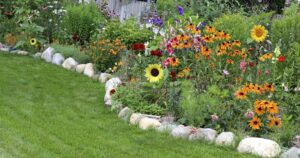
CHOOSE FLOWER EDGING FOR NATURAL BORDERS
One of the most vibrant garden-edging ideas is an abundance of gladiolus, dahlia, and lilies to keep your area feeling a little airier. Incorporate additional plants for scent, such as thyme, lavender, and rosemary, and make sure to maintain some evergreens for structure throughout the year. Recall that you can create the desired separation in your garden by adding height to your flower bed ideas, which also double as garden gravel path edging ideas.
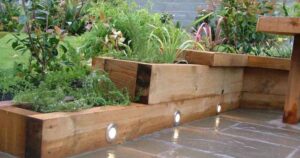
USE SLEEPERS TO DIY GARDEN EDGING
You can DIY a natural garden edge using sleepers like this one from Wayfair to make a mini garden bench as well as sturdy lawn edging. A place to sit and also to house your beautiful plants; It is too easy. It is one of those low-maintenance garden ideas, suitable even for beginners, and also one of the best alternatives to grass.
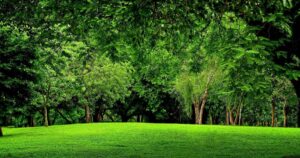
LINE BRIGHT BORDERS WITH NATURAL ROCKS
Another lovely and organic option for a natural garden edge is rocks. They look great and are quite effective at keeping their place if you anchor them firmly; they are relatively easy to install. In terms of size and shape, there is also greater variation. Plus, the DIY is rather inexpensive. Use a gorgeous flower mix from Suttons or your neighborhood natures edge garden center to cover your beds. How to Grow Lemongrass.
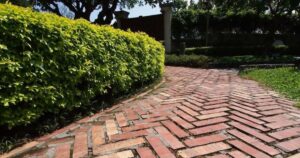
EDGE YOUR GARDEN PATHWAYS WITH BRICK
In addition to providing a charming rustic finish to your borders, edging your garden with brick will ensure that mulch for evergreens and other garden plants stays in place. For a DIY project that is even less expensive, use reclaimed bricks. The delicate style is ideal for cottage-style gardens.

USE ROPED EDGING POSTS FOR MODERN DEFINITION
Do you wish to give your lawn edging more definition? A perfect finish and a more contemporary natural garden edge appearance can be attained with the help of edging posts. Haddonstone is the source of these roped edging posts, which look great used as border edging or lawn edging.

CHEAT WITH PLASTIC LAWN EDGING FOR A REAL STONE EFFECT
Natural stone garden edging-effect plastic lawn edging is a great option if you’re searching for low-cost garden ideas that are still visually appealing and simple to install. Its lawn edging is easy to install and maintain and looks good because it is made of durable polymer Triumph.
Amazon is the source for Maison & White’sWhite’s Grey Stone Effect Lawn Edging. Our recommendation? No one will ever know it’s plastic if you bury it a little deeper than it is depicted here and plant right up to it in your garden borders. But your garden will appear really well-kept.
FLAGSTONE GARDEN EDGING
Edging your garden beds with flagstones gives them a classic look, especially suitable for country and cottage gardens. Flagstone is available in various colors and thicknesses, so you can easily use it to blend or contrast your plants, other landscape natural edge masonry, or even masonry in your home. Irregular in shape, the slabs are durable and stack securely in the garden.
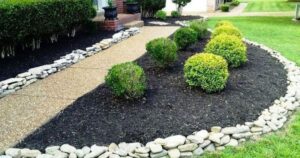
ROCK GARDEN EDGIN
Mix and match different colored and shaped rocks to create a natural edge garden mulch bed stone garden border. Large multicolored rocks complement the informal style of this landscape. Sweet alyssum creeps over and between the rounded boulders, which are arranged in a winding pattern, giving the landscaped flower bed a lacy, scalloped appearance.
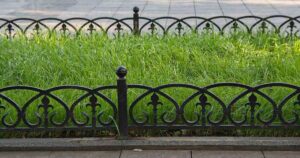
METAL GARDEN EDGING
Metal edge options include aluminum or steel. Aluminum edges are harder to find, but they are the best option because they don’tdon’t rust and are lighter than steel edges, making them easier to transport.
Both aluminum and steel edging come in different colors to match the mulch you have in your flower beds. Metal edges are made to be subtle (sometimes almost invisible), as you can see in the example shown above.
In addition to blending easily into the landscape metal edging can also be easy to install. Some sorts come in “no-dig” panels, meaning all you have to do is stick them into the ground instead of digging a trench, which many styles of edging require.
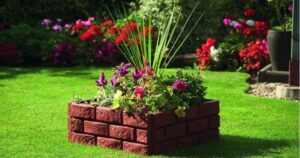
PLASTIC GARDEN EDGING
Plastic edging comes in individual no-dig panels for easy installation or in long rolls that you can install with a trench. The top of the plastic rim usually sticks out of the ground, so its metal is more subtle. However, this is one of the least expensive options so that the aesthetic sacrifice might be worth it for you.
You can find smooth black plastic edging at almost any natures edge garden center or home improvement store. You will usually see regular, sturdy thicknesses. Opt for thicker options if possible, as they are more durable and can withstand hits from the lawnmower. Rubber edges look and function similarly to plastic edges.
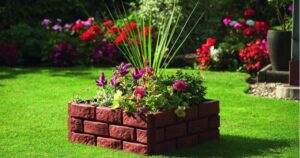
COBBLESTONE GARDEN EDGING
This landscape is shaped by a hedge of Korean boxwood and square cobbles of granite garden edging. The enormous leaves of “Annabelle” and oak leaf hydrangeas contrast with the textures and shapes of the paving, edging, and hedge, adding billowing white blooms.
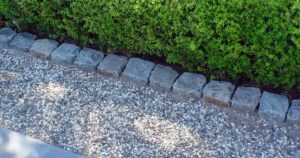
BRICK GARDEN EDGING
Brick edging is a traditional landscaping look that can complement a brick home. Like pavers, these will be more complicated to install than simple borders. Please note that occasionally, it can be difficult to level all the bricks.
When purchasing bricks to use in your garden, make sure you know the difference between pavers and regular bricks. You can use regular bricks for landscape edging, but they are softer and more likely to break.
GARDEN EDGING IDEA WITH PLANS
Low-lying, mounding plants make excellent natures edge garden center bemidji mn choices for landscaping. Low-growing plantings of sweet alyssum (pictured here), veronica, bouncing bet, artemisia, coralbells, or candytuft soften sharp edges and add a pop of color when arranged in a single long mass of draping color.
DIAGONAL BRICK GARDEN EDGING
For a natures edge garden center bemidji mn that evokes the grandeur of the 19th century, arrange ancient, uneven bricks perpendicularly. To prevent the bricks from heaving, dig a trench and fill it with several inches of sand for drainage. Place the bricks in the trench with half of them exposed and tightly stacked one on top of the other, then cover them with dirt. Make sure all of the bricks are pointing in the same direction when edging multiple garden beds.
RECYCLED-BOTTLE GARDEN EDGING
Edge your landscape with colorful glass bottles to give your garden a whimsical, homey look. Bury the necks of the bottles side by side in the soil to use as a garden edging. To prevent grass or weeds from migrating from the lawn to your flower beds, sink a sheet of aluminum flashing about 8 inches into the ground next to the bottles.
CONCRETE GARDEN EDGING
Another everlasting border for a landscape is concrete curbing ideas. If you prefer a more customized shape, you can use poured concrete, concrete curbing ideas or precast concrete pavers.
In the event that you decide on a poured concrete border, professional landscape assistance is likely required. Remember that you won’t be able to change the shape of your bed. Your garden border for flagstone patio will be cemented in place when concrete is poured.
CAST CONCRETE EDGING
This landscape’slandscape’s winding path is created by the concrete garden edging, which also makes mowing easier. Different heights create interest and enable an uneven or smooth transition between landscape features.
WOOD GARDEN EDGING
You can select from an expansive variety of styles if you want wood garden edging. Installing small individual pieces in square panels or shaped like a natural log would be an option.
You can use long landscape timber slabs for a rectangular garden bed. Even wood garden fences are available for decoration; however, they are typically less effective at keeping mulch in place.
The exact look you’re going for will determine what kind of wood you use for garden edging. Make sure the wood you select is treated so that it won’t rot.
NATURAL ROCK GARDEN EDGING
If you want to create a more wild appearance for your landscape, garden edging natural stone rocks make the ideal garden border. You can prevent the grass from overgrowing your flower beds without going overboard by adding boulders, river rocks, or even pea gravel path edging ideas.
When positioning the rocks, take great care. Avoid leaving any spaces for weeds or renegade grass to grow through.
USE WOOD GARDEN EDGING TO ADD HEIGHT
Wooden lawn edging is especially useful for cottage gardens and rustic garden designs. For a more modern flower bed border look, stain or paint it, or leave it with a natural edge garden mulch bed for a more understated appearance. These pressure-treated, FSC-certified wood materials are used to make this natural timber lawn edging from B&Q. It fits very easily without the need for fixing pegs thanks to the spiked ends.
PICK RECYCLED PLASTIC LAWN EDGING FOR ECO-FRIENDLY VIBES
Recycled lawn edging is undoubtedly something to think about if you’re concerned about cutting waste and creating an environmentally friendly garden. The flexible, frost-, mold-, and rot-resistant recycled garden border from Waitrose Garden is made from recycled tires and is available in a range of textured patterns.
PEBBLE LAWN EDGING
Pebbles are great for creating a natural look in the garden, but you should know that pebbles have a reputation for not staying in place. This pebble edging from Coopers of Stortford is mounted on mesh, making it easy to place and ensuring the pebbles don’tdon’t move.
KEEP GARDEN EDGING NEAT AND MODERN WITH METAL
The above-galvanized steel lawn edging from UK company Waitrose Garden is a versatile, simple-to-install solution that will shield your lawn from erosion and strimmer damage. This kind of lawn edging has the great quality of not rusting and is essentially maintenance-free once installed. It is ideal for modern flower bed border garden designs and ideas.
USE LOW BOX HEDGE AS GARDEN EDGING
Natural garden edging can be achieved with dense, low-growing hedge plants; all you need to do is remember to trim them annually with a hedge trimmer. The best shrub for this is unquestionably the traditional box hedge. It can be precisely trimmed to the height and shape you need while keeping the thickness necessary for garden edging.
MARK OUT A GARDEN POND WITH PAVED EDGING
Paved garden edging will make any natural water feature, such as a garden pond, in your backyard look even more beautiful. All you have to do is line the perimeter of your pond with patio-type natural stone garden edging pavers. It can be paired with raw lawn edging and will look more natural than brick.
What is the Trench Edging Landscape?
According to Kronk, the cheapest garden edging is “plastic pavers that you drive into the ground.” They are very easy to install and really look good, but they could be more durable and scratch very easily. Your lawnmower or trimmer will damage them on contact.”
Kristina Matthew, landscape designer and co-founder of the blog Gardennatures.com prefers to work with no-dig materials for a cost-effective garden edging solution. She explains that “these materials require no digging and can be stacked on top of each other to beautify your gardens, such as river stones, terracotta pots or bricks.” All of these materials are very easy to obtain and install to give a well-kept touch to your lawn.”
FAQ
How do you maintain garden edges?
Your flower bed’s brass edge should be cut with a spade, half-moon edger, or another similar instrument. You will need to perform this task on a regular basis if you choose not to install garden edging.
You won’t need to bother about maintaining your garden border or lawn edging with any of the materials we’ve listed here.


